People from all across the world have long liked salami, a form of cured sausage. It is typically prepared with fermented and air-dried pork and, once cut, can be kept at room temperature for up to 45 days.

People who live in locations where fresh meat might not always be easily accessible find it to be a popular option because of this.
Salami comes in a range of forms, proportions, and tastes. Lean and fat pig shoulder and back cuts are often combined, packed into a sausage casing, and air-cured for a few weeks or months to produce this product.
Salt, spices, and occasionally wine or other alcoholic beverages are used to flavor the meat during this time. Depending on the particular ingredients used in the curing process, different types of salami may have distinctive flavor characteristics.
Even though salami is frequently linked with Italian food, it is a favorite among consumers throughout. In reality, rather than referring to a specific kind of meat, the word “salami” has Latin origins and describes a mixture of salty meats.
There is no doubting that salami is a delicious and adaptable complement to any meal, whether you prefer it thinly sliced and heaped high on a sandwich or presented as part of a charcuterie board.
What is Salami?
Salami is a type of cured meat that has been enjoyed for centuries. It is typically made from ground meat, which is mixed with various spices and seasonings and then stuffed into a casing. The meat is then allowed to ferment and dry, which gives it its distinctive flavor and texture.
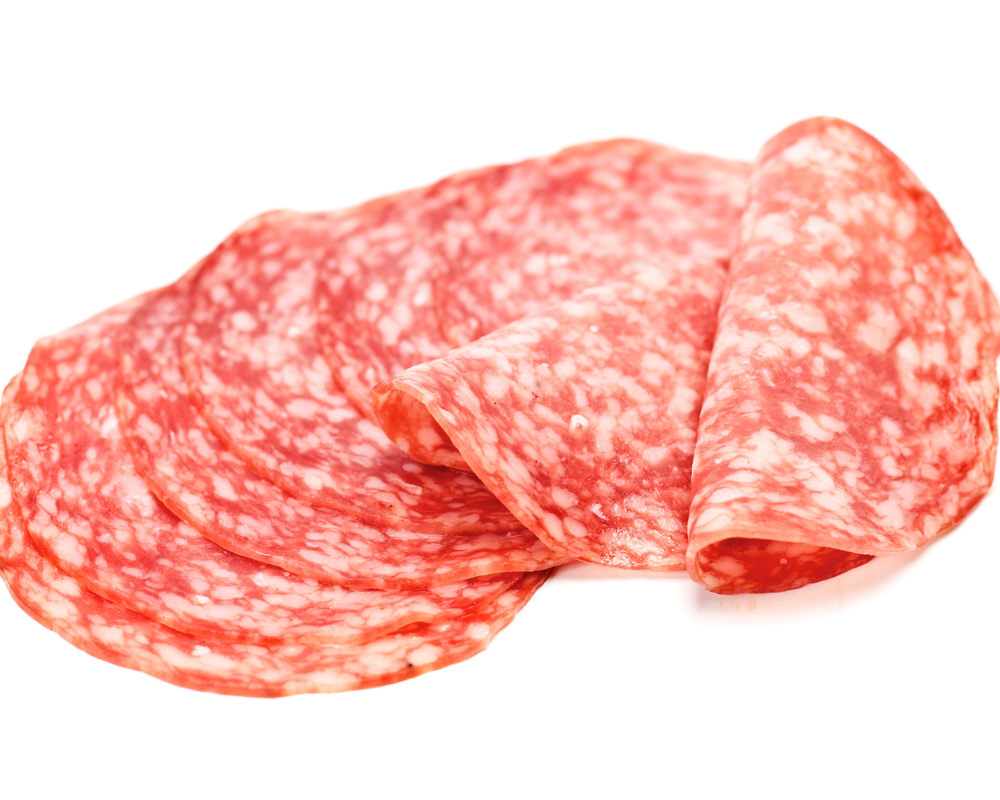
Salami is often associated with Italian cuisine, but it is actually a type of cured meat that is enjoyed all over the world. In Italy, salami is known as “salame,” and there are many different varieties available. Some of the most popular types of salami include:
- Genoa Salami: This is a type of salami that originated in the city of Genoa. It is typically made from pork and flavored with garlic, peppercorns, and red wine.
- Soppressata: This is a type of salami that is popular in southern Italy. It is made from coarsely ground pork and flavored with red pepper flakes.
- Pepperoni: While not technically a type of salami, pepperoni is a type of cured sausage that is similar in flavor and texture. It is typically made from beef and pork and flavored with paprika and chili powder.
Salami can be enjoyed on its own as a snack, or it can be used as an ingredient in a variety of dishes. It is often sliced thin and served on a charcuterie board, along with other cured meats and cheeses. It can also be used as a topping for pizza or added to sandwiches and salads for extra flavor.
Overall, salami is a delicious and versatile type of cured meat that can be enjoyed in many different ways. Whether you prefer the spicy kick of soppressata or the classic flavor of Genoa salami, there is sure to be a variety that appeals to your taste buds.
Types of Salami
Salami is a popular cured meat that has been enjoyed for centuries. There are many different types of salami, each with its own unique flavor and texture. Here are some of the most common types of salami:

- Pepperoni: This is a type of salami that is popular in the United States. It is made from a mixture of beef and pork and is flavored with paprika, garlic, and other spices. Pepperoni is often used as a pizza topping.
- Genoa: Genoa salami is a specific type of salami that originates in the Genoa region of Italy. It is a medium grind, garlic-heavy salami with a smooth rich flavor and clean finish. Genoa salami is often used in sandwiches and antipasto platters.
- Cured Salami: This type of salami is cured using salt and other natural ingredients. It is often aged for several months, which gives it a rich, complex flavor. Cured salami can be made from a variety of meats, including beef, pork, and game.
- Finocchiona: This is a type of salami that is flavored with fennel seeds. It is a popular variety in Tuscany, Italy. The fennel seeds give the salami a unique flavor that is both sweet and savory.
- Soppressata: This is a type of salami that is made from coarsely ground pork. It is flavored with garlic, red pepper flakes, and other spices. Soppressata has a spicy, tangy flavor and is often used in sandwiches and pasta dishes.
- Chorizo: Chorizo is a type of salami that is popular in Spain and Latin America. It is made from ground pork and is flavored with smoked paprika and other spices. Chorizo has a smoky, spicy flavor and is often used in stews and soups.
- Italian Sausage: This is a type of salami that is made from ground pork and is flavored with fennel, garlic, and other spices. Italian sausage is often used in pasta dishes and on pizza.
- Cacciatore: Cacciatore is a type of salami that is made from coarsely ground pork. It is flavored with garlic, red pepper flakes, and other spices. Cacciatore has a spicy, tangy flavor and is often used in sandwiches and antipasto platters.
- Napoletano: This is a type of salami that is popular in Naples, Italy. It is made from coarsely ground pork and is flavored with garlic, red pepper flakes, and other spices. Napoletano has a spicy, tangy flavor and is often used in sandwiches and pasta dishes.
- Ciauscolo: This is a type of salami that is popular in the Marche region of Italy. It is made from ground pork and is flavored with garlic, red pepper flakes, and other spices. Ciauscolo has a soft, spreadable texture and is often served on bread.
- Capicola: Capicola is a type of salami that is made from pork shoulder. It is flavored with red pepper flakes and other spices. Capicola has a rich, savory flavor and is often used in sandwiches and antipasto platters.
- Pancetta: Pancetta is a type of salami that is made from pork belly. It is flavored with salt, pepper, and other spices. Pancetta has a rich, smoky flavor and is often used in pasta dishes and on pizza.
- Peppered Salami: This is a type of salami that is coated in black pepper. It is often made from beef or pork and has a spicy, savory flavor. Peppered salami is often used in sandwiches and antipasto platters.
Overall, there are many different types of salami to choose from, each with its own unique flavor and texture. Whether you prefer spicy, tangy, or savory flavors, there is a salami out there for you.
Ingredients in Salami
When it comes to salami, the ingredients used can vary depending on the specific type of salami being made.

However, some of the most common ingredients used in salami are pork, beef, and fat. These three ingredients are usually combined in different ratios to create the desired texture and flavor of the salami.
In addition to pork, beef, and fat, salt is another essential ingredient in salami. Salt is used to cure the meat and give it its characteristic flavor. Some salami makers also use sea salt, which has a different flavor profile than regular table salt.
Spices are also a key ingredient in salami. Garlic, fennel, black pepper, coriander, mace, and cinnamon are just a few of the spices that are commonly used in salami. These spices are usually added in small amounts to enhance the flavor of the meat.
Cheese is another ingredient that is sometimes added to salami. This is usually done by mixing small pieces of cheese into the meat mixture before it is stuffed into casings. The cheese adds an extra layer of flavor and texture to the salami.
Sugar is sometimes added to salami as well. This is usually done to balance out the saltiness of the meat. Some salami makers also use wine in their recipes, which can add a unique flavor to the salami.
Preservatives are often added to salami to extend its shelf life. These preservatives can include celery powder, which contains natural nitrates, and antioxidants, which help prevent the meat from spoiling.
Finally, starter cultures and lactic acid bacteria are used to ferment the meat and give it its characteristic tangy flavor. These cultures are usually added to the meat mixture before it is stuffed into casings.
Overall, salami is a complex food that requires a careful balance of ingredients to achieve the desired flavor and texture.
By using a combination of pork, beef, fat, salt, spices, and other ingredients, salami makers are able to create a wide variety of delicious salamis that are enjoyed all over the world.
Curing and Fermentation of Salami
When it comes to making salami, fermentation and curing are two essential processes that give salami its characteristic flavor and texture.
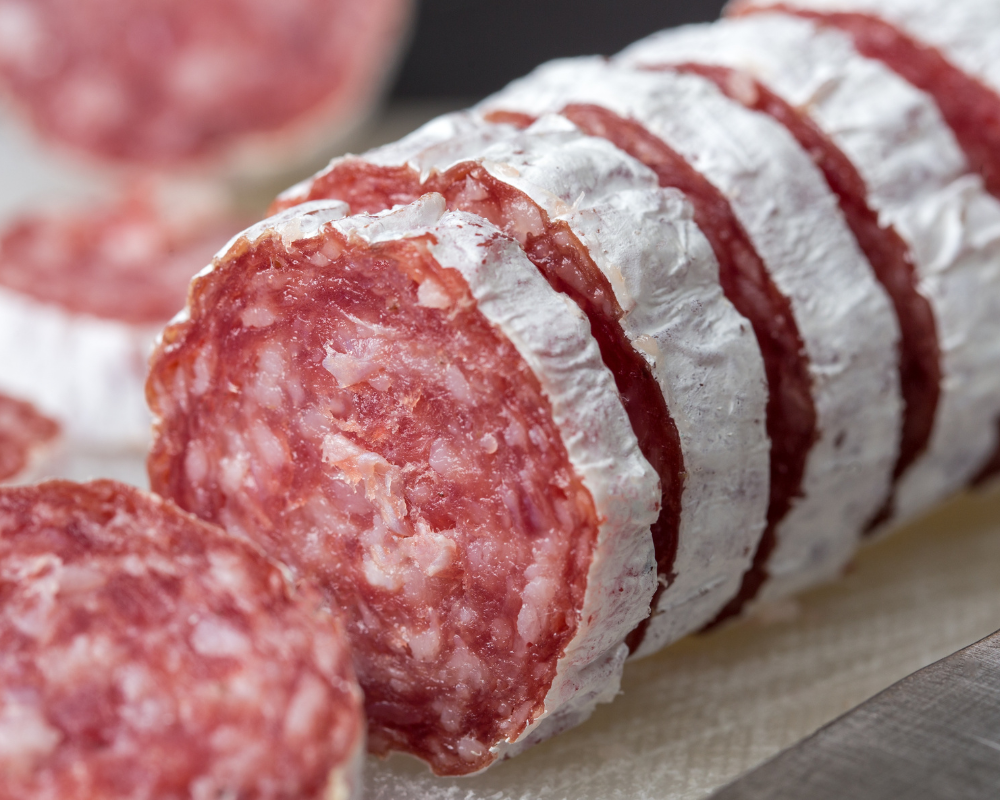
Fermentation is the process by which lactic acid bacteria (LAB) convert the sugars in the meat into lactic acid, which lowers the pH of the meat. This drop in pH makes the meat more acidic, which helps to prevent the growth of harmful bacteria.
To start the fermentation process, a starter culture is added to the meat. The starter culture contains LAB that are specifically chosen for their ability to ferment meat.
During fermentation, the temperature and humidity of the curing environment are carefully controlled to ensure that the LAB can work efficiently. The ideal temperature for fermentation is around 20-25°C (68-77°F), and the humidity should be kept at around 85-90%.
The fermentation process can take anywhere from a few days to several weeks, depending on the type of salami being made and the desired flavor profile.
Once fermentation is complete, the salami enters the drying phase. During this phase, the salami is hung in a temperature and humidity-controlled environment, where it slowly loses moisture and develops its characteristic texture.
The drying process can take anywhere from a few weeks to several months, depending on the size of the salami and the desired level of dryness.
During both the fermentation and drying phases, the salami is also exposed to mold. This mold helps to develop the flavor of the salami and gives it its characteristic white coating.
While some molds are harmful, the molds used in salami production are safe to consume and play an important role in the flavor development of the salami.
In addition to fermentation and drying, nitrites are often added to salami during the curing process. Nitrites help to prevent the growth of harmful bacteria and also give the salami its characteristic pink color.
However, nitrites can be harmful if consumed in large quantities, so it is important to consume salami in moderation.
Overall, the curing and fermentation processes are what give salami its unique flavor and texture. By carefully controlling the temperature, humidity, and other factors, we can create delicious salami that is safe to consume and a true delight for the taste buds.
Nutrition and Health Benefits of Salami
When it comes to nutrition, salami is a good source of protein, vitamins, and minerals. It is also low in carbohydrates and calories, making it a great option for individuals who are watching their weight.
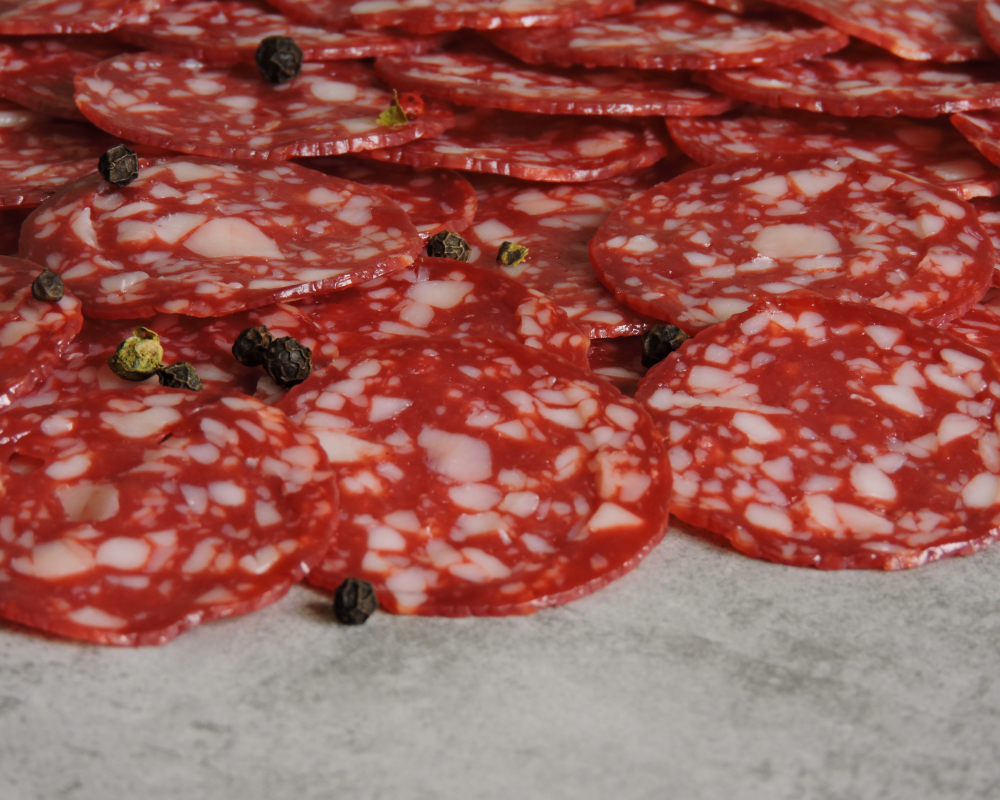
One of the key nutrients found in salami is vitamin B12, which is essential for maintaining brain function and a healthy nervous system.
In fact, just one serving of salami can provide us with a significant amount of vitamin B12, which is especially important for individuals following a vegan or vegetarian diet.
Salami is also high in protein, which is essential for building and repairing muscles, as well as maintaining healthy skin, hair, and nails. Additionally, salami contains several important minerals, including zinc, which is necessary for DNA synthesis, wound healing, and immune health.
Another important nutrient found in salami is niacin, which is important for maintaining healthy skin, nerves, and digestion. Niacin also helps to lower cholesterol levels and improve blood pressure, which can reduce the risk of heart disease.
While salami is high in sodium, it is also low in water activity, which means that it is less likely to spoil or harbor harmful bacteria. Additionally, salami contains antioxidants, which can help to protect our cells from damage and reduce the risk of chronic diseases.
Overall, salami can be a healthy and delicious addition to our diet, as long as we consume it in moderation and choose high-quality, nitrate-free options whenever possible.
Shelf Life and Storage of Salami
When it comes to salami, it’s important to know how long it lasts and how to store it properly to ensure it stays fresh and safe to eat. Salami has a relatively short shelf life, so it’s essential to consume it quickly.
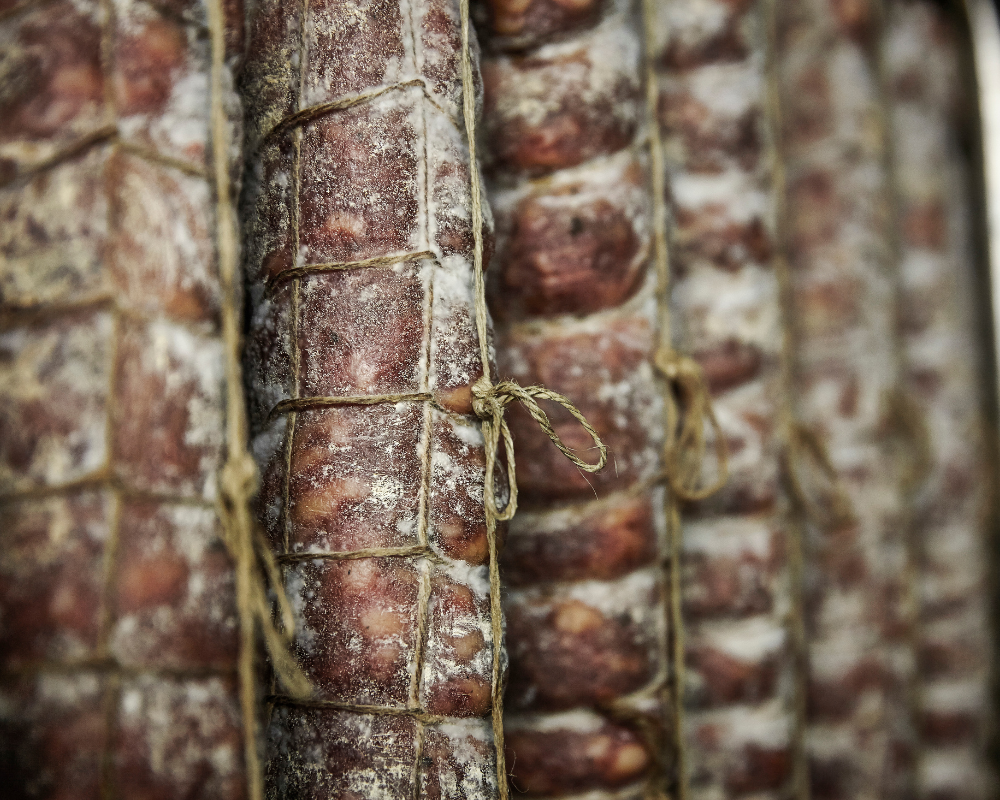
According to the USDA, unopened salami lasts for up to six weeks in the pantry, but it dries out the longer it sits. Once you open the salami, it’s best to eat it within three to five days. You can wrap it properly with plastic or foil in an airtight container to help prolong its shelf life.
If you’re unsure whether the meat is still safe to eat, use your senses. Look for any signs of mold or discoloration, and smell for any off odors. If it smells bad or has a slimy texture, it’s best to throw it away.
It’s also important to note that the shelf life of salami depends on how it’s processed. Uncured salami has a shorter shelf life than cured pork salami. Salame cotto, which is cooked salami, has a longer shelf life than raw salami.
When it comes to storing salami, it’s best to keep it in a cool, dry place. Avoid storing it in direct sunlight or in a warm environment, as this can cause the salami to spoil faster.
It’s also worth noting that salami is a high-sodium food, so it’s important to consume it in moderation. While it can be a delicious delicacy, it’s best to enjoy it as an occasional treat rather than a regular part of your diet.
When purchasing salami, it’s important to buy it from a reputable source, such as a butcher shop or deli. This ensures that it’s made with high-quality ingredients and processed using the latest technology.
Overall, salami is a delicious and versatile processed meat that can be enjoyed in many different ways. By following these tips for shelf life and storage, you can ensure that your salami stays fresh and safe to eat.
Traditional Italian Cured Meats
When it comes to cured meats, Italy is the undisputed king. From prosciutto to mortadella, Italian cured meats are known for their unique flavors and textures. Here are some of the most popular traditional Italian cured meats.
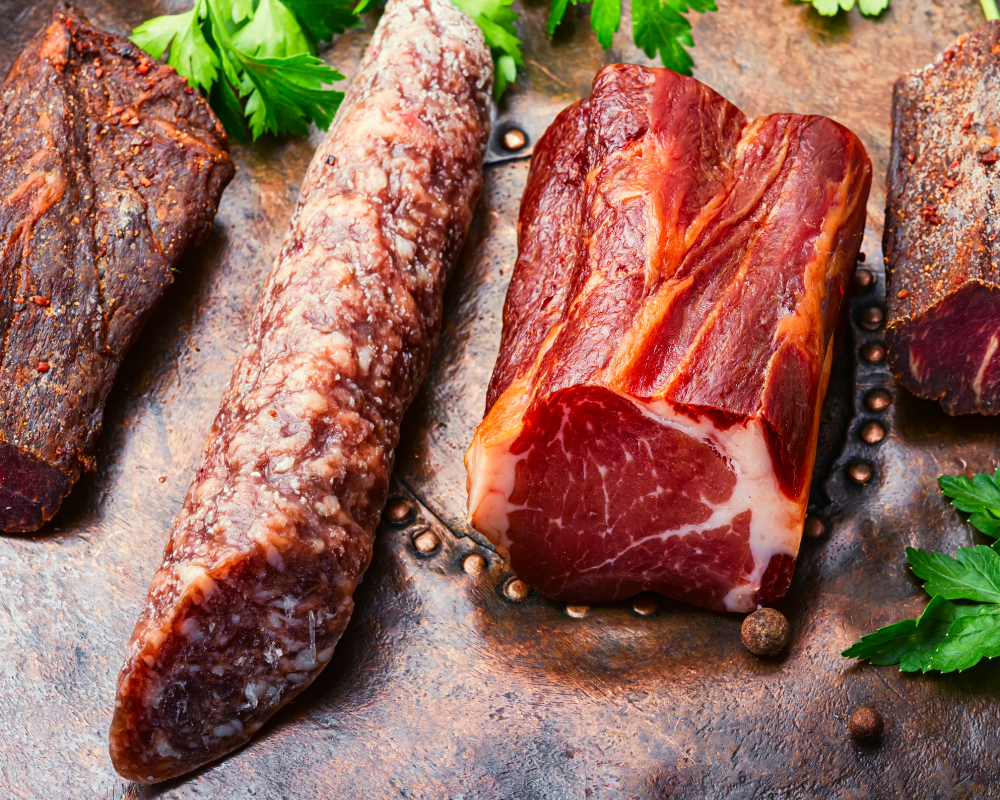
Prosciutto
Prosciutto is a dry-cured ham that comes from the leg of the pig. It’s usually sliced thin and eaten as an appetizer or in sandwiches.
There are two main types of prosciutto: prosciutto crudo and prosciutto cotto. The former is uncooked and has a delicate flavor, while the latter is cooked and has a firmer texture.
Mortadella
Mortadella is a large, finely ground sausage that’s made with pork, beef, or a combination of the two. It’s flavored with spices like pepper, coriander, and nutmeg, and often includes cubes of pork fat. Mortadella is typically sliced thin and served as a cold cut.
Felino Salami
Felino salami is a type of dry-cured salami that comes from the town of Felino in the Emilia-Romagna region of Italy. It’s made with pork, salt, and spices like pepper and garlic. Felino salami has a delicate flavor and a soft texture.
Finocchiona Salami
Finocchiona salami is a type of dry-cured salami that’s flavored with fennel seeds. It’s made with pork, salt, and spices like pepper and garlic. Finocchiona salami has a distinctive anise flavor and a firm texture.
Italian Cured Meats
Italian cured meats are known for their unique flavors and textures. They’re made using traditional methods that have been passed down for generations. Italian cured meats are often served as appetizers or in sandwiches, and they’re a staple of Italian cuisine.
Overall, Italian cured meats are a delicious and important part of Italian cuisine. Whether you’re enjoying prosciutto as an appetizer or mortadella in a sandwich, these cured meats are sure to satisfy your taste buds.
How to Enjoy Salami
When it comes to enjoying salami, the possibilities are endless. Here are a few ideas to get your creative juices flowing:
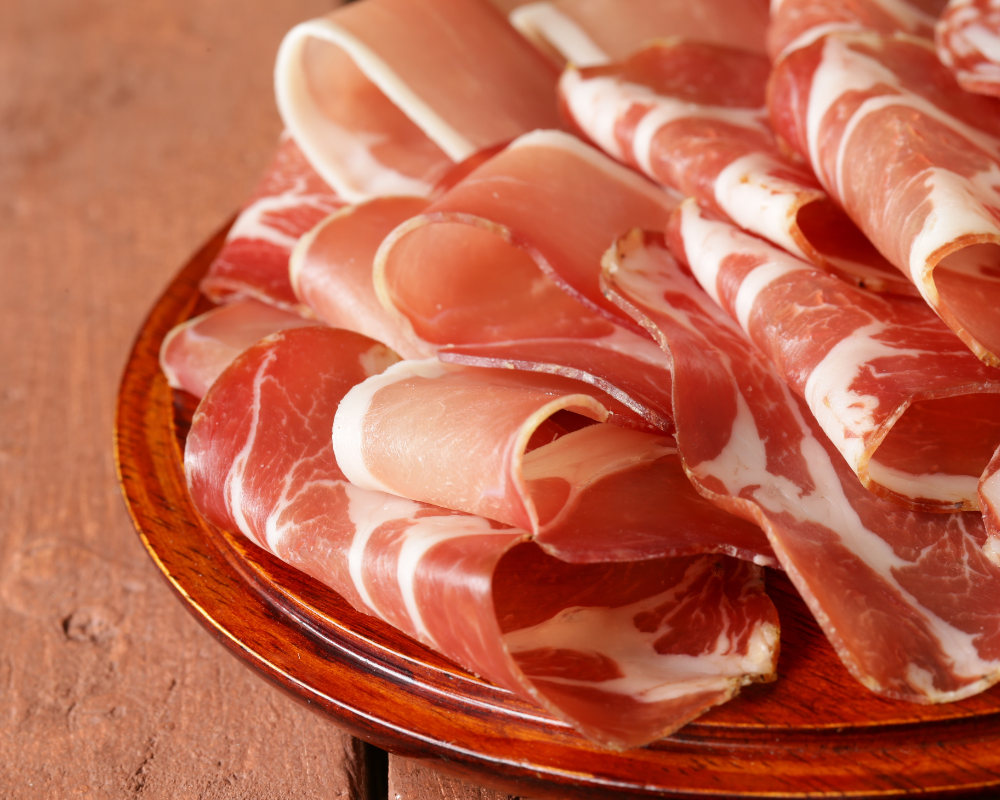
Sandwiches
Salami is a classic sandwich ingredient that adds a delicious savory flavor. Slice it thin and layer it with your favorite cheese, lettuce, tomato, and condiments for a tasty lunchtime treat. You can also use it in a panini or grilled cheese sandwich for an extra special twist.
Pizza
Salami is a popular pizza topping that adds a salty, meaty flavor. Use it as a substitute for pepperoni or sausage, or combine it with other toppings like mushrooms, onions, and peppers for a delicious pizza pie.
Appetizers
Salami makes a great appetizer when sliced thin and served with crackers, cheese, and fruit. You can also use it to make a charcuterie board, along with other cured meats, olives, and nuts.
American Version
In the United States, salami is often made with beef and has a slightly different flavor than traditional Italian salami. It’s commonly used in sandwiches and as a pizza topping, but can also be enjoyed on its own as a snack.
No matter how you choose to enjoy salami, be sure to store it properly in the refrigerator and use it within a week of opening. Slice it thin for the best flavor and texture, and experiment with different varieties to find your favorite.







Add comment